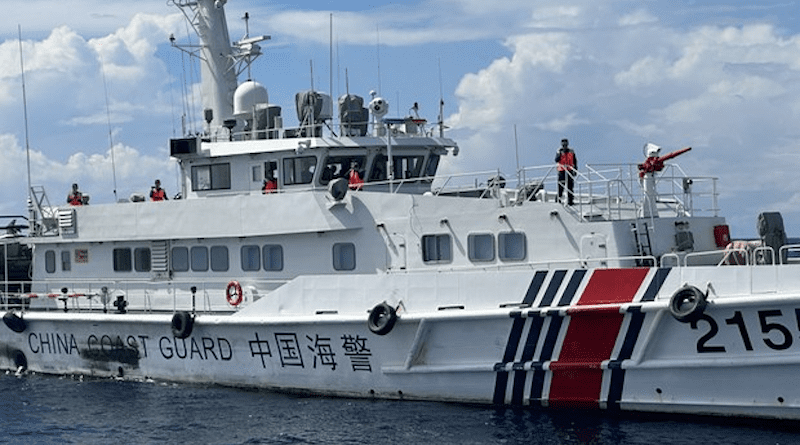China Loses Strategic Waters In The South China Sea – Analysis
By Gregory Poling
From 2012 to 2021, Beijing steadily advanced its claim to ‘historic rights’ in most of the waters, seabed, and airspace of the South China Sea, using coercion and threats of force to do so. But since 2022, the momentum has shifted. Southeast Asian claimants have stopped giving ground.
The most well-reported South China Sea story of 2023 was the ongoing crisis around Second Thomas Shoal where Manila is determined to repair the BRP Sierra Madre. Every month, the Philippine Coast Guard (PCG) has escorted civilian ships to resupply Manila’s troops aboard the grounded ship. And every month, the China Coast Guard (CCG) and militia have employed dangerous but non-kinetic tactics to block them, so far without success. The Philippines has also re-established a regular presence around Scarborough Shoal for the first time since 2012 despite similar Chinese grey zone tactics.
The CCG was accused of using a military-grade laser to temporarily blind a Filipino crew member in February 2023, followed by a series of near collisions as Chinese vessels sought to block the path of Philippine ships. The CCG also turned watercannons on Philippine government and civilian ships around Second Thomas and Scarborough Shoal.
In October 2023, Chinese ships twice collided with Philippine counterparts around Second Thomas. Another collision took place two months later, this time involving a Philippine ship carrying Armed Forces of the Philippines Chief of Staff Romeo Brawner. March 2024 saw a third collision, while a CCG water cannon shattered the windshield of another Philippine vessel. That incident injured four sailors including the admiral in command of the Philippine Navy’s Western Command.
In each of these cases, the Philippines made sure that government and civilian cameras were there to capture the aggression, while US patrol aircraft often circled overhead. Over and over, the Philippine ships got through the blockades.
With Xi Jinping having embedded the maximalist pursuit of South China Sea claims in his political program, Beijing is unable or unwilling to change tack. It is also unprepared to use military force to win Second Thomas, only to risk compromising its larger goals of regional and global leadership.
Manila’s public relations campaign might create the impression that only the Philippines is flouting China’s grey zone pressure. But other claimants have consistently found success against Beijing since late 2021. Vietnam has tripled the size of its facilities in the Spratlys, building new harbours and accompanying infrastructure to deploy patrol vessels to the islands, which had previously been the exclusive prerogative of China. Vietnam also continues to develop oil and gas fields around Vanguard Bank despite daily CCG patrols.
Even less remarked upon, Indonesia has developed the Tuna gas field despite regular harassment by the CCG. Malaysia also goes about its business at Kasawari and other oil and gas fields, despite also being targeted by the CCG.
These developments on the water are matched with deepening security partnerships and diplomatic activity in response to China’s behaviour. The US–Philippines alliance is closerthan at any point since at least the 1970s and Manila is deepening its security partnerships with Australia and Japan. The government of President Ferdinand ‘Bongbong’ Marcos has begun to rebuild the international coalition supporting the Philippines’ 2016 arbitration victory, which his predecessor Rodrigo Duterte had shelved. In 2022, India, South Korea and much of the European Union publicly called on China to comply with the ruling for the first time.
The Marcos government is also exploring the possibility of filing a second arbitration case, focused on China’s environmental destruction in the South China Sea. In November 2023, Marcos suggested that it is time for Southeast Asian claimants to pursue negotiations on a code of conduct among themselves, which could help break the two-decade logjam in ASEAN–China negotiations.
The Philippines is not alone in its diplomatic efforts. In September 2023, US President Joe Biden visited Hanoi to conclude a new US–Vietnam Comprehensive Strategic Partnership — the same level Vietnam maintains with China. Hanoi quickly followed this with Comprehensive Strategic Partnerships with Japan and Australia.
Farther south, Indonesia has been uncomfortably reminded since 2021 that it is in fact a party to the maritime disputes. The Indonesian security services have become steadily more worried about China after the CCG harassed exploratory drilling operations at the Tuna block. While this evolution has been muffled by the relative disinterest of President Joko Widodo, that could change in 2024. Incoming president and current Defence Minister Prabowo Subianto is more likely to publicly amplify voices in the security services that want to push back on Chinese coercion.
Malaysia, under Prime Minister Anwar Ibrahim, has been the odd one out, saying almost nothing about the South China Sea.
The South China Sea will remain unpredictable in 2024. But momentum has shifted in favour of the Southeast Asian claimants. China cannot control the South China Sea without moving from grey zone coercion to outright military force — and the latter would cost far more than it would gain. The only viable path forward would be to dial back coercion in favour of pragmatic cooperation with fellow claimants. But Beijing shows no sign of changing tactics on the water, nor a willingness to engage in more productive diplomacy.
- About the author: Gregory Poling is Senior Fellow and Director of the Southeast Asia Program and the Asia Maritime Transparency Initiative at the Center for Strategic and International Studies (CSIS), Washington DC.
- Source: This article was published by East Asia Forum

